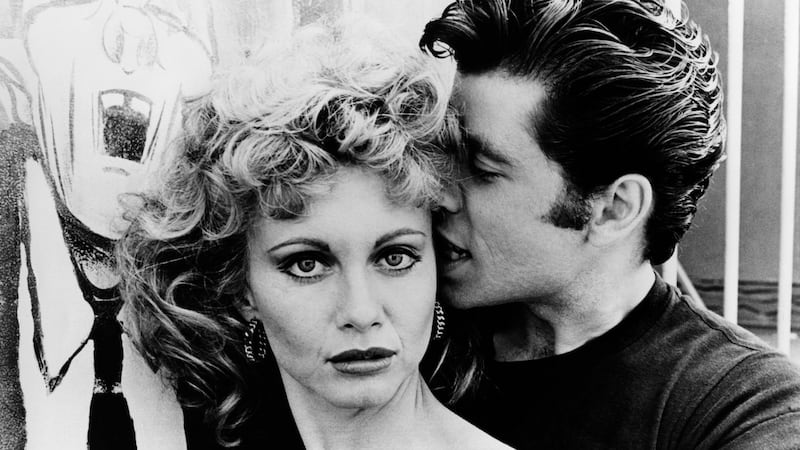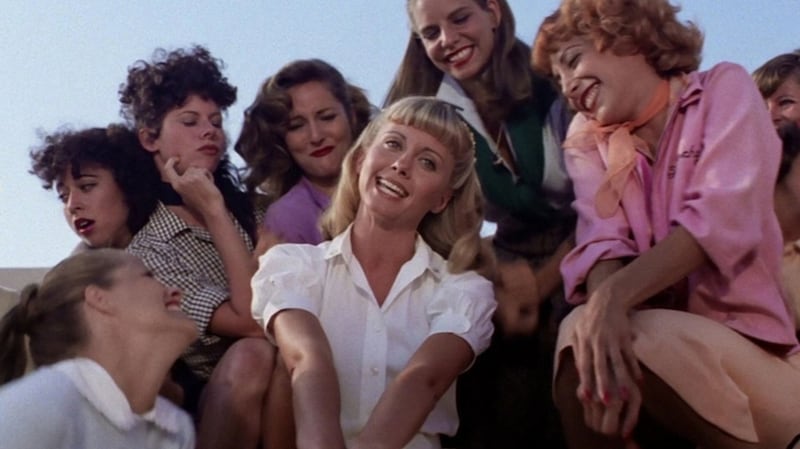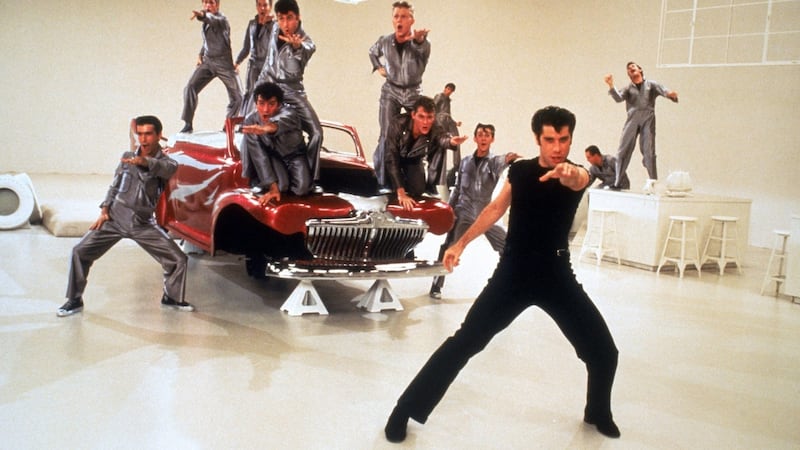The summer of 1958, in which Grease was set, looked a beguiling cocktail of hormonally charged lindy hops, leather pants and all-round frivolity. Which is a damn sight more than can be said about the summer of 1978, when Grease was filmed. A year after the Summer of Sam, the US was mired in social and political unrest, and the wider world wasn't faring much better. The former Italian prime minister Aldo Moro was kidnapped and murdered by the Red Brigades. Pope John Paul, head of the Roman Catholic church for just over a month died, and Georgi Markov, a Bulgarian dissident, was murdered in London with an umbrella that carried a poison pellet.
To say that Grease was the film the world needed is barely overstating the case. Not that the critics of 1978 knew it. The film – an adaptation of a 1971 musical of the same name – received a lukewarm reception immediately on its cinematic release (which in Ireland, was on September 15th, 1978).
Perhaps it was a hangover of plain old 1970s film snobbery: one critic deemed it a “grave disappointment to anyone in search of style or substance”. Still, it didn’t take long for the sugar-rush of a film to find its feet. The tale was, even by then, as old as time – boy meets girl, boy loses girl, both spend the next hour or so trying to win each other back.
Grease became the breakout hit of the year, and remains second only to Beauty and the Beast as the most successful musical film
Yet Grease became the breakout hit of the year, and remains second only to Beauty and the Beast as the most successful musical film.
Its success took everyone by surprise: "It's important to remember that it wasn't meant to be a big popular hit – it was made on a low, $6 million budget with a 30-year-old director," says Prof Diane Negra, head of film studies at the School of English, Drama and Film at UCD.
“The 1970s were a period in which Hollywood was coming to grips with the post- [Motion Picture] production code period. It’s a decade we associate with Hollywood’s greatest films but there was a lot of uncertainty about what would be a hit with the public.
“Added to this, social change and economic change was remaking American life. Much of the film’s appeal has to do with timing, looking as it did at the idyll of the 1950s – a particularly cherished time in American history – with the hindsight that a 1970s lens affords.

"The baby boomers were the generation with most power in Hollywood at the time, and they were fixated on their own past," recalls Negra. "It's amazing how many hits from the 1970s were set in the past, from Little House on the Prairie and Laverne & Shirley to Happy Days. This preoccupation with the 1950s that happened in the 1970s happened during a period of malaise. A lot of that pop culture material was harking back to the confident postwar years."
Stephen Tropiano, author of Grease, agrees.
"A lot of people say that Grease was a response to the 1960s because they were so turbulent," he says. "Nostalgia is not something that's supposed to be accurate, but this film really did define the [1950s] era. At the same time, it was so smart and it was so contemporary in terms of its music [including songs composed by the Bee Gees]."
High school fantasy
That Grease was one of the prototypical coming of age films – a genre often relegated to cult fare – also helped to put bums on seats. That the teenager really came into its own in the 1950s with its own culture and argot was a happy coincidence.
"The power of the high school prom is a ritual in American life, and an incredibly important moment of change in the lives of Americans coming of age," adds Negra. "What a song like We Go Together is a foretelling of separation and the permanent disruption of the community."
Tropiano has noted that Grease offered a look at more rounded or relatable high-schoolers, beyond the typical jock/geek tropes.
Had producers had their own way, the stellar cast almost wouldn't have happened: their original choices for Danny and Sandy were Henry Winkler and Susan Dey
“The characters are supposed to be the cool kids in school, probably the kids we all wanted to be,” he notes. “They make fun of the jocks. In the musical, there’s even more raunchiness and rebellion and it’s a true high school fantasy. You wish you were the cool kid, and that’s why it’s easy to spend time with them for two hours. Sandy is the outsider who comes in, and we feel like those outsiders. Eventually, she gets to join them.”
According to Tropiano, the chemistry of the cast was a huge draw too, even if, as the New York Times' Vincent Canby noted, they were old enough to be their own parents (sure enough, Stockard Channing, who played Rizzo, was 33 at the time of filming). Had producers had their own way, the stellar cast almost wouldn't have happened: their original choices for the starring roles of Danny and Sandy were Happy Days' Henry Winkler and The Partridge Family's Susan Dey.
"The movie could have gone off in a different direction if [John Travolta and Olivia Newton-John] weren't so likeable," he says. "It's really something to have a lead couple who you want to be, and who you want to be able to get together. It was the perfect storm. Olivia is really this genuine, sweet person and that has a lot to do with her appeal. Travolta meanwhile, really has that star quality, and this role really shows it."
Dark edges
It was no confection either: apparently Travolta (Danny) was hopelessly devoted to Newton-John (Sandy) during filming – a crush, alas, that evidently went unrequited.
“You really can’t discount the commercial power of Travolta’s dancing body in the 1970s,” says Negra. “Newton-John was somewhat untested in movies at the time, but people have long talked about Travolta’s charisma at this point in his career. The way in which his star power drove the project is quite interesting.”
Travolta's doing or not, Grease's appeal has only galvanized in the last four decades, becoming a multi-generational hit that has barely faded in time.

In fact, some of its more contentious lynchpins – among them the toxic masculinity that riddles Rydell High, and the slut-shaming that "bad girl" Rizzo endures – have barely dented its lasting appeal. Some moments certainly take on a different hue in the #MeToo era, among them the line "did she put up a fight?" in Summer Nights, or the moment where Marty catches the much older TV anchor Vince Fontaine putting aspirin in her Coca-Cola.
“It’s useful for a film like this to have some dark edges,” says Negra. “It’s a very sunny film with a few dark spots, more than people remember.”
Sure enough, it transpires that Rizzo's pregnancy scare almost didn't make the final cut (Channing begged with producers to keep it in). Elsewhere, one deleted scene would have changed the tone of the film entirely. Producer Allen Carr revealed that one scene between T-Bird Kenickie and Pink Lady Rizzo had been deleted. Several months after Grease had wrapped, an executive at Paramount wanted a scene that offered the motivation behind Rizzo's hostility toward Kenickie at the diner.
At his urging, they shot a scene that showed a dramatic argument between the two characters.
"Two-hundred thousand dollars went to do the scene, which I call the Martin Scorcese scene," Carr says. "It's against a black wall, and they have this vicious fight... It was very good, but certainly had nothing to do with our movie."
The American dream
With the tone duly set, Grease was seismic not just as a prototypical teen movie, but as a film that challenged (as opposed to upholding) sexism on both sides. In another bold move for its time, it offered sufficient story arcs to most of its female characters. Could Grease be called a feminist film? Perhaps.
A more woke audience might baulk at the contention that Sandy has to change who she is to end up with Danny. Yet scratch the surface and it becomes apparent that Sandy doesn't change for Danny: rather, she throws off the cosseting constraints of the time to become more true to herself. In his essay Inside Grease, writer Scott Miller astutely observes: "Today, it may be hard to understand what Sandra Dee (who Rizzo compared Sandy to) represented, but she was the poster girl for the big studios' attempts to make teen movies. And many American girls took Sandra Dee as a role model. Millions of Americans in postwar America were trying to live an American dream that was pure fiction, particularly for the working class; and that fiction is symbolised by Sandra Dee, a fiction at the heart of Sandy's arc in Grease."
I think younger generations of moviegoers will watch <em> Grease </em>through the lens of satire. The film is so over the top
Put another way, Negra observes: "Grease works as a narrative because it put together an exemplary couple and demonstrated their ability to change for each other."
Millennial audiences, similarly, could have a pop at the toxic masculinity that runs through Grease, yet it's more multifaceted than first meets the eye. Danny's masculine posturing is often undermined by his innate sensitivity, and by the end he has managed to throw off the shackles entirely to get the girl.
"I think younger generations of moviegoers will watch Grease through the lens of satire," contends Negra. "The film is so over the top, it makes itself available in that regard on so many levels."
Adds Tropiano: "I went to a singalong in Los Angeles a few years ago at the Hollywood Bowl, and it really was people of all generations. I think it's one of those films where the appeal has been really maintained by the young audience, whereas an older audience will still see it as a huge nostalgia part of their lives."
FIVE THINGS YOU DIDN’T KNOW ABOUT GREASE
1 Most of the characters decided to go method, more for fun than any dedication to the craft. "What was so much fun was that most of us were older than the characters we were playing so we just stayed in character all day long," Didi Conn (Frenchy) is quoted as saying. "Let's just say some of the trailers were rocking and rolling during filming."
2 There's a reported alternative ending to the film, which might possibly see the light of day thanks to its 40th anniversary in which Danny and Sandy kiss in the ascending car as it flies away from Rydell High. During filming, Travolta decided to improvise, and in the end, the audience can see that while Newton-John is surprised, she also responds.

3 They may have stayed in teenage characters during shooting, but Stockard Channing brought "grown-up" brownies to the wrap party that everyone enjoyed. "I really don't remember much, just dancing and lying on the floor laughing with everybody," says Conn.
4 The day they filmed the scene for Look At Me, I'm Sandra Dee – a song in which Rizzo sings "Elvis, Elvis, let me be; keep that pelvis far from me" – was August 16th, 1977, the day Elvis Presley died.
5 Ellen Travolta (John's sister) has a cameo in the film – she plays the diner waitress that says, "oh, there's Danny and Sandy" as the staff watch the dance on TV.





















